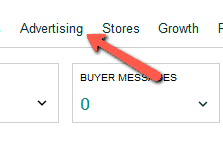Article Summary (TL;DR)
✅ Amazon offers various ad types like Sponsored Products, Brands, and Display Ads to boost product visibility and sales.
✅ FBA sellers benefit from increased visibility, keyword targeting, and brand awareness through Amazon advertising.
✅ Setting up Amazon ads involves creating campaigns, choosing targeting options, monitoring performance, and continuous optimization.
There are different types of Amazon ads.
Amazon offers several advertising options to help sellers and brands promote their products, increase visibility, and drive sales on the platform. These advertising options can be accessed through Amazon Advertising.
Different Types of Amazon Ads Campaigns

Amazon advertising works by allowing sellers and brands to create and manage advertising campaigns to promote their products and increase visibility on the Amazon platform.
With the different types of Amazon ads, you can create custom ads that will allow you to have more visibility in the Amazon Platform.
Amazon’s advertising ecosystem includes various advertising solutions. each advertising solution can target a wide range of prospective customers. If you want to reach shoppers through Amazon Ads is the way to go.
The key components and ad formats include the following:
Sponsored Products
These are pay-per-click (PPC) ads that appear in Amazon search results and on product detail pages. Sellers bid on keywords, and their products are displayed when customers search for those terms.
Sponsored Brands (formerly Headline Search Ads)
Sponsored Brands allow brand-registered sellers to create ads that feature their brand logo, a custom headline, and a selection of products. These ads typically appear at the top of search results and help increase brand visibility.
Sponsored Display
Sponsored Display ads allow advertisers to retarget potential customers both on and off Amazon. They can appear on Amazon, on third-party websites, and within Amazon DSP campaigns.
Amazon Stores
Brand-registered sellers can create their Amazon Stores, which are customizable, branded storefronts to showcase their product catalog. These stores serve as a hub for a brand’s products and allow for a more immersive shopping experience.
Video Ads
Video ads enable sellers and brands to use video content to promote their products. These ads can appear on Amazon and across the web.
Display Ads via Amazon DSP
Amazon’s Demand-Side Platform (DSP) allows advertisers to run display advertising campaigns across the web and mobile, targeting specific audience segments with the help of Amazon’s vast data.
Amazon Posts
This is a relatively new feature that allows brands to create content about product sales on Amazon that resembles social media posts. Shoppers can discover and engage with these posts, leading them to product detail pages.
🗣️ Pro Tip: These ad types are the key components to know if you’re an FBA seller.
Amazon Live
Amazon Live enables brands to livestream video content directly to users on their Amazon storefronts. This interactive format allows brands to engage with customers in real-time.
Coupons
Sellers can offer digital coupons to incentivize shoppers to purchase their products. These coupons are typically highlighted on product detail pages.
Display Advertising on Fire TV
Advertisers can run display ads on Amazon Fire TV devices, reaching viewers as they watch streaming content.
Amazon Attribution
This tool allows advertisers to measure the impact of their advertising efforts both on and off Amazon, providing insights into how different channels contribute to sales.
Posts in Amazon Fresh
This feature is designed for brands to create shoppable content on Amazon Fresh, Amazon’s grocery delivery service.
Custom Advertising Solutions
For larger brands and agencies, Amazon offers custom advertising solutions and dedicated support to create tailored campaigns.
Amazon Audio Ads
Amazon’s audio advertising allows brands to reach customers through audio content on Amazon Music and Audible.
How Can Amazon FBA Sellers Benefit from Amazon Advertising?

Fulfillment by Amazon (FBA) sellers can benefit from Amazon advertising in several ways, as it provides opportunities to increase product visibility, attract more customers, and boost sales.
Here are some of the key benefits of Amazon advertising for FBA sellers:
Increased Visibility
Amazon advertising helps FBA sellers get their products in front of a larger and more targeted audience. Sponsored Products, Sponsored Brands, and other ad formats allow products to appear prominently in search results, increasing their visibility.
Keyword Targeting
FBA sellers can use keyword targeting to ensure their ads are displayed to customers actively searching for products similar to theirs. This can lead to higher conversion rates.
Enhanced Brand Awareness
Sponsored Brands, in particular, help FBA sellers build and reinforce their brand presence on Amazon. They can showcase their logo and brand story and promote a curated selection of products, which can lead to higher brand recognition.
Improved Sales
Amazon advertising can directly impact sales and revenue. When optimized effectively, ad campaigns can lead to a higher click-through rate (CTR) and conversion rate, resulting in increased sales.
Control Over Budget
FBA sellers have control over their advertising budget, allowing them to set daily or lifetime campaign budgets. This ensures that vendors’ advertising expenses remain within their desired limits.
Performance Metrics
Amazon provides detailed performance metrics and insights for advertising campaigns. Sellers can track key metrics, such as click-through rates, conversion rates, and return on ad spend (ROAS), allowing them to refine and optimize their campaigns over time.
🗣️ Pro Tip: Amazon ads provides opportunities to increase product visibility, attract more customers, and boost sales.
Competitive Advantage
Using Amazon advertising, FBA sellers can compete more effectively with other sellers and brands in their product categories. They can gain an edge by promoting their products strategically.
Seasonal Promotions
Sellers can use Amazon advertising to promote their products during specific seasons or holidays when demand is higher. This flexibility allows for targeted marketing efforts.
Cross-Promotion
Sellers can use advertising to cross-promote related products, encouraging customers to buy multiple items, which can increase the company’s average order value.
Ad Placement Options
Amazon offers various ad placements, such as search results, product detail pages, and even off-Amazon advertising through Amazon DSP. This diverse set of placements can reach customers at different stages of the buying journey.
Remarketing
With Sponsored Display and other retargeting options, FBA sellers can re-engage customers who have previously shown interest in their products but did not make a purchase.
Data-Driven Insights
Amazon advertising provides valuable data and insights that can inform product strategies and inventory management. Sellers can identify high-performing products, customer demographics, and popular search terms.
Ad Campaign Flexibility
Sellers can adjust and fine-tune their ad campaigns based on real-time performance data. This flexibility allows for continuous optimization.
Support for New Product Launches
When launching new products, FBA sellers can use Amazon advertising to generate initial visibility and sales, helping to kickstart product success.
It’s important for FBA sellers to approach Amazon advertising with a well-thought-out business strategy and a clear understanding of their target audience. Regular monitoring and optimization of ad campaigns are crucial for maximizing the benefits of Amazon advertising.
How to Set Up an Amazon Advertising Account for FBA Sellers

If you want to advertise on Amazon, you need to follow multiple steps to create and manage effective advertising campaigns.
Here’s a general guide on how to set up Amazon advertising:
- Amazon Seller Account:
- You must have an Amazon Seller account to access Amazon Advertising. If you don’t have one, sign up for an Amazon Seller account.
- Product Listings:
- Ensure your products are listed on Amazon with clear and compelling product titles, descriptions, and images. Properly optimized product listings are crucial for the success of your advertising campaigns.
- Brand Registry (for brand-registered sellers):
- If you’re a brand-registered seller, consider enrolling your brand in Amazon Brand Registry. This provides additional advertising and brand protection benefits.
- Access Amazon Advertising:
- Sign in to your Amazon Seller Central account.
- Navigate to the “Advertising” section to access Amazon Advertising.
- Choose the Right Campaign Type:
- Determine the type of advertising campaign that suits your goals. The primary campaign types include Sponsored Products, Sponsored Display, and Sponsored Brands.
- For more advanced advertising, you can also explore Amazon Stores, video ads, and external advertising via Amazon DSP.
- Create a Campaign:
- Click “Create Campaign” and follow the prompts to set up your campaign.
- You’ll need to define your campaign’s budget, start and end dates, and targeting options.
- Choose Your Targeting Options:
- Select your targeting options, which can include keyword targeting, product targeting, and audience targeting.
- For Sponsored Products and Sponsored Brands, choose relevant keywords and products.
- For Sponsored Display, consider retargeting and audience targeting options.
- Set Bids and Budget:
- Determine your bidding strategy, such as manual or automatic bidding.
- Set a daily or lifetime budget to control your ad spend.
- Create Ad Creative:
- For Sponsored Products and Sponsored Brands, create ad creative, including headlines, product images, and ad copy.
- Make sure your ad creative is compelling and relevant to the targeted keywords or products.
- Review and Submit:
- Review your campaign settings, targeting options, and ad creative.
- Once you’re satisfied, submit your campaign.
- Monitor and Optimize:
- After your campaign goes live, regularly monitor its performance through Amazon Advertising’s reporting tools.
- Adjust your bids, keywords, and ad creative based on performance data to optimize your campaigns.
- A/B Testing:
- Consider running A/B tests to compare different ad creatives and strategies to identify what works best for your products.
- Amazon Attribution:
- If you want to track the impact of your advertising efforts both on and off Amazon, consider using Amazon Attribution.
- Ad Compliance:
- Ensure your ads comply with Amazon’s advertising policies and guidelines to avoid any issues with ad approval.
- External Advertising:
- If you want to extend your advertising efforts beyond Amazon, you can explore Amazon’s Demand-Side Platform (DSP) for external advertising campaigns.
- Branded Content (for brand-registered sellers):
- Consider enhancing your product detail pages with A+ Content (Enhanced Brand Content) or even creating an Amazon Store to provide a branded shopping experience.
- Evaluate and Refine:
- Continuously evaluate the performance of your campaigns and make data-driven decisions to improve results over time.
Final Words
Getting ahead in Amazon needs effort and time. But your time and effort can be augmented if you use the right tools that Amazon provides like its advertising platform.
As a vendor, advertisement can be a powerful tool for your business, especially in Amazon. And setting up Amazon advertising is an ongoing process that involves careful planning, testing, and optimization to achieve your advertising goals.
It’s vital to stay up to date with Amazon’s advertising policies and guidelines and leverage the analytics and reporting tools provided to refine your campaigns.
Comments
Related Posts

10 Profitable Product Categories for Amazon Affiliates 2025
What you’ll learn Amazon is a favorite for experienced and…

Unlock the Secret to a Profitable Automated Amazon Store: How to Build a Hands-Free Income Stream
Ever dreamed of running a profitable Amazon business while sipping…

Master Amazon New Restricted Keywords: A Seller’s Guide to Success
Changes to Amazon’s restricted keywords list have taken a lot…







Leave a Reply